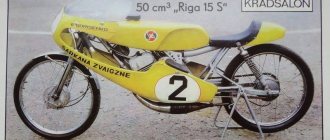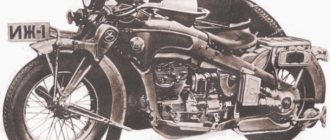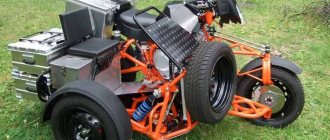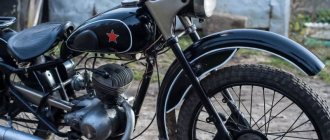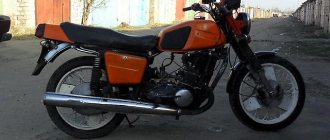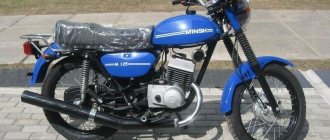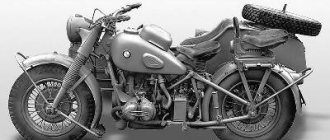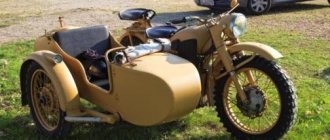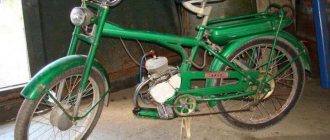"Riga-16" is a Soviet-era moped, the production of which began in the seventies of the last century at . The unit received a motorcycle-type muffler, two-speed transmission, an updated kick starter, and a rear brake lever. In addition, the brake light and steering wheel were improved, and the product was painted in several variations. The starting versions were equipped with the Sh-57 power unit, further modifications of this series were equipped with the Sh-58 engine. With a mass of 115 kilograms, the mokik is capable of transporting more than a hundredweight of additional cargo.
Historical facts
Rizhsky began production of small-capacity two-wheeled motor vehicles back in 1958. The first models were “Spiriditis” mopeds, produced under license from the “Java” plant. The start turned out to be not entirely successful, and after consultation with Czech colleagues, the developers mastered their own production of the Riga series. The starting modification was equipped with a power unit with a volume of fifty cubic centimeters.
Over forty years of activity, Riga designers have produced many modifications of one- and two-speed motorcycles, a miniature scooter under the symbol “26” and the famous light motorcycles “Delta” and “Stella”. Production of Riga-16 began in 1977 and lasted five years. After the collapse of the Soviet Union, the plant was stopped and sold piecemeal.
Features and innovations
"Riga-16" is a moped that has received a large number of innovations and design changes compared to its predecessors. The main thing in this list of innovations was equipping the unit with a kick starter. Before this, the vast majority of motorcycles in this class were produced with pedal drive.
Along with the modified engine start, the designers improved the motor itself, which, thanks to its simplicity and reliability, became practically the standard of its time for users. The Riga-16 moped received two main color variations. An updated rear light, a new trunk shape, a footrest and a brake lever can also be considered the most successful innovations in the development of the model in question.
And off we go
"Riga-1". Ancestor
Was released in the mentioned 60th year. For experience and familiarization with advanced design solutions, we made one trip to exchange experience to the Czechoslovak motorcycle plant “Java”, whose products had already become loved by many residents of the USSR.
Moped "Riga-1"
A foreign engine was also brought from there, which is considered the basis of the success of “Riga” among the people. It was produced from 61 to 65, the number of copies was about two hundred thousand. With a weight of 45 kg and a tank volume of 6 liters, it could accelerate to 45 km/h.
"Riga-3".
In 1961, the first Soviet motorbike “Gyaua” was released, which quickly won the hearts of millions of Soviet boys. And according to the documentation, it looked like the Riga-2 model.
In 1965, a change of generations occurred and “Riga-3” took the place of “Riga-1”. The engine was changed to a domestic one, which dramatically affected the quality of the motorcycle itself and its popularity among the people. But despite this, the power of the vehicle itself has increased. Now he could accelerate to 50 km/h.
“Riga-4” and “Riga-5”.
The next moped in the generation, in fact, was no different from its predecessor, except for a few new engineering solutions, which, however, did not make a difference. Produced from '68 to '74.
Moped "Riga-5"
“Riga-5” already had more noticeable changes and innovations. First of all, it’s worth noting the new design. A new engine was installed to increase the mobility of the moped.
Expert opinion
Kobelman David Borisovich
Soviet and Russian scientist, specialist in the field of astrophysics and physics of gravitational systems. Professor, Hero of Socialist Labor, Lenin Prize laureate.
It was freed from the flaw of the previous series, when at high speeds it could either stall or “choke itself” on fuel. Improved grip; Now it was possible to take the steepest climbs by storm. The production and production of this model began in 1966 and finished in 1975.
“Riga-7”
The main innovation is the engine of the new model. In general, the remaining changes were either cosmetic in nature, or did not introduce any serious innovations into the design of the moped.
“Riga-11”
And again without significant changes. Except that a few bad decisions were made regarding the design of the moped. For example, the fuel tank was now located under the trunk.
"Riga-11"
And this significantly complicated the upward movement if the road was steep enough. But the frame turned out to be fragile, fragile and very short-lived.
“Riga-12”
Now the moped could better overcome difficult sections of the road. There were versions with different mounting options for the fuel tank.
“Riga-13”
He reached speeds of up to 40 km/h. Unlike previous models, it had good headlights and became more comfortable to drive. But now there was a problem with the ignition, which, due to engine shortcomings, often went astray or stopped working.
“Riga-16”
It was distinguished by the most successful version of the engine of all produced models. Now the ride has become smoother, the steering is more responsive, and the ride itself is much more comfortable. They also changed the design of the steering wheel and installed a taillight on a moped for the first time.
“Riga-17S”
Released in 1983. Engine power has increased significantly - up to 16.5 hp. Such indicators made it possible to reach a maximum speed of 100 km/h, which was simply an exorbitant figure for mopeds.
Mini mokik "Riga-26"
But it should be noted that this model was intended more for sports and various motorcycle competitions than for civilian use.
“Riga-22”
Unlike the Riga-17S, this model can be considered a direct continuation of the sixteen. It featured a new type of engine. Innovations have made it possible to significantly improve the ignition box, which has a positive effect on the reliability of engine starting. The moped itself could accelerate to 50 km/h and had a fuel tank with a capacity of 8 liters.
“Riga-26” or “Pura mini”
Released in 1982, it was a hybrid of a moped and a scooter, combining the advantages of both the first and the second.
Expert opinion
Isaac Yakovich Zelder
Soviet astrophysicist, physical chemist, Doctor of Physical and Mathematical Sciences, Academician of the USSR Academy of Sciences, designer, engineer. Hero of Socialist Labor of the USSR.
It had small dimensions, but, however, a solid weight of 50 kg, which made it difficult to transport manually, for example, to the fifth floor of your apartment. It stood out for its height adjustment.
After certain manipulations, it became comfortable for a 6-year-old child to ride. Although who would let such a trifle drive?
“Delta” and “Riga SZ-80”
In 1986, production of the main series of mopeds continued. The continuation of the business was “Delta”, which was distinguished by a flashy colorful design and chrome parts.
Moped Delta Riga 24
The Riga SZ-80 can be considered more interesting in terms of innovation, even though it was produced in parallel with the main series. During its production, we collaborated with motor plants of the GDR, where a license for the new engine was purchased. It had a very high speed, like for a moped - somewhere around 120 km/h. It also had a double seat and excellent hydraulic brakes by Soviet standards.
Moped "Riga-16": technical characteristics
Below are the main parameters of the Soviet mokik:
- power plant - Sh-57/Sh58 with a power of 2.2 horsepower and a volume of 49.8 cubic centimeters;
- maximum speed – 50 kilometers per hour;
- muffler - motorcycle type;
- weight – 75 kilograms;
- improved steering wheel;
- years of production - from 1978 to 1982;
- length x width x height – 1.97 x 0.74 x 1.16 meters;
- tire size - 2.15/ (sixteen-inch tires);
- frame type – welded spinal structure.
Given its mass, the Riga-16 moped, the photo of which is below, could transport more than 110 kilograms. In addition to the driver, even a large passenger could fit in a comfortable seat.
Power point
Regarding the engine of this vehicle, the following can be noted:
- two-stroke carburetor engine brand D-6;
- its working volume is forty-five cubic centimeters;
- cooling – air with chamber blowing (crank device);
- cylinder size is 38 millimeters;
- compression ratio - 6, with a piston stroke of 4.4 centimeters;
- The engine produces maximum efficiency of 1.2 horsepower at four and a half thousand rpm.
The Soviet moped is equipped with a single-speed gearbox, a double-disc friction clutch, and reaches a torque of up to 29 Nm. The power unit is started by turning the pedals. The ignition unit is a magnetic system. The exhaust exhaust is released through a muffler with partitions for throttling. With a gear ratio of 4.2, the identical chain drive value is 4.1 (the carburetor used is K-34).
More details about the motor and main components
The following are the parameters of the power unit and fuel system:
- engine type – Sh-57, Sh-57 s, Sh-58;
- power - two horsepower, or one and a half kilowatts;
- gearbox - two-stage unit with manual drive;
- clutch block - double-disc version in an oil bath;
- starting the power unit - Sh-57 (pedals), Sh-58 (kick starter);
- fuel – AI-76 gasoline;
- fuel consumption per hundred kilometers – 1.6 liters;
- gear ratio - 3.08.
Studying the characteristics of the Riga-16 moped, it can be noted that it is equipped with a K-35V (K-60) gasoline carburetor, has a contact ignition system with a magneto, and is equipped with a dry air strainer filter.
Consumer Reviews
Despite the fact that more than a dozen years have passed since the release of the modification in question, you can still find the rare device in working condition. Of course, finding original parts for it is almost impossible. But, thanks to the ease of maintenance and repair, it is quite possible to repair the motor yourself with minimal skills.
The owners of the device note a number of positive aspects of the Riga moped:
- new and more comfortable steering wheel design;
- improved seating;
- optimal combination of unit weight and its load capacity;
- stable wheels compared to predecessors;
- starting the engine using a kick starter;
- strong and reliable frame.
The disadvantages for users of this model include problems with engine components typical of Soviet vehicles of this class, a capricious gearbox and a not-so-perfect brake system.
Peculiarities
"Riga-16" is a moped that replaced the thirteenth modification. The main difference was the presence of a motorcycle-type muffler, a new starting system, and a more advanced and comfortable steering wheel shape. The modernization of the sixteenth series was carried out in 1981. The new model received the index “22” and was equipped with the Sh-62 engine. The power plant was radically different from its predecessors.
The engine received contactless electronic ignition. In addition, the new Mokick was equipped with a different gearbox. Despite this, the speed switching unit remained the weak link of the device in question (the quality of its manufacturing let us down). Subsequently, the Riga plant focused on the production of mopeds of a completely different type, which are similar to light motorcycles and are known under the names “Mini”, “Delta” and “Stella”.
Device of other nodes
The saddle design has been improved. His box has become more powerful, and the thickness of the pillow has also increased. This solution made it possible to make the driver’s seat more comfortable and increase the usable space for storing tools. The seat spring is fixed with new elements, ensuring the reliability of the entire assembly.
The fuel tank, together with the trunk, is located at the rear of the moped, forming an impressive platform capable of supporting 15-20 kilograms of cargo. The volume of the fuel tank is four liters. This reserve is enough for about two hundred kilometers.
Thanks to its solid power reserve, Riga-11 is a moped that has become popular both among city residents and in rural areas. The engine remains the same, but the chain is made in a new, stronger and more durable version. Due to the wide tires, the engine was shifted to the right of the symmetrical point of the frame by seven millimeters. This made it possible to position the front and rear sprocket in the same plane.
Interesting Facts
It's worth o - a moped that has a lot in common with its closest competitors in the workshop and class. This is especially true for the appearance of the twelfth, eleventh and thirteenth models. But if you look closely at the details, you can note that the option under consideration has a more convenient shape and fastening of the steering wheel, the brake and clutch lever has a rubber tip in the form of a ball, the rear light is located more conveniently and has a more attractive shape.
The engine of the sixteenth version is almost the same as that of Riga-12, only with a kick starter. The mokika saddle is elongated and elastic, it is comfortable even on long trips. Several color options allow you to choose the unit according to your personal preferences. The popularity of the device was also influenced by its affordability, ease of operation, maintenance and repair.
Appearance of "Riga-Mini"
The appearance of the moped is quite simple. At that time, small-capacity models differed little from each other; the model range of Riga mopeds was very similar. But, in this case, the main difference between “Riga” was its dimensions. Due to this, the model was quite popular. A headlight was installed in front, which ensures driving in the dark. There are fenders at the back and front that prevent dust and rainwater from getting on the driver and the motor. Behind the roomy driver's seat is a “modest” trunk, immediately behind which is a brake light. As mentioned earlier, the steering wheel and seat are adjustable. That is, the ability to “tailor” the equipment individually to each person makes the model very universal.
A lot of criticism was directed towards the Riga's handling. In particular, many were not satisfied with the tires, which were very hard. If they were damaged or punctured, it was very difficult to determine this. That is, the movement was carried out on an empty wheel. Due to the small size of the wheels, when they fell into a hole, the discs were often deformed. Therefore, many people preferred the Verkhovyna moped, whose technical characteristics were close to the Riga, but the wheels were still larger.
User guide
“Riga-16” is a moped, the instruction manual of which includes standard provisions, is distinguished by its original design and unpretentiousness. Main sections of the manual:
- Device design and equipment.
- Advice on the use of fuels and lubricants.
- Timing of preventive and major maintenance.
- Recommendations for the repair of individual components and parts.
- Technical specifications.
After studying the instructions, almost any user can replace seals, spark plugs, fixing elements, light elements and other collapsible components.
